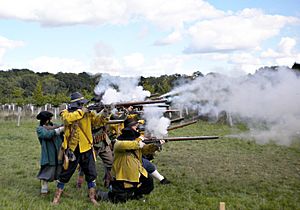Battle of Braddock Down facts for kids
Quick facts for kids Battle of Braddock Down |
|||||||
|---|---|---|---|---|---|---|---|
| Part of the First English Civil War | |||||||
 Historical re-enactment of the Battle of Braddock Down in England |
|||||||
|
|||||||
| Belligerents | |||||||
| Commanders and leaders | |||||||
| Sir Ralph Hopton | William Ruthven | ||||||
| Strength | |||||||
| 5,000 | 4,000 | ||||||
| Casualties and losses | |||||||
| Low | 200 killed 1,500 captured |
||||||
The Battle of Braddock Down was an important fight during the First English Civil War. This war was fought between supporters of King Charles I (called Royalists) and supporters of the Parliament (called Parliamentarians). The battle took place on open land in Cornwall on January 19, 1643.
It was a clear win for the Royalists, led by Sir Ralph Hopton. This victory helped the King's side control Cornwall. Sir Ralph Hopton became known as a skilled commander. He also earned respect for being kind to the defeated enemy. About 1,500 Parliamentarian soldiers were captured during and after the battle. The exact spot where the battle happened is still debated today. However, English Heritage believes it was in the parkland at Boconnoc.
Contents
Preparing for Battle: The Prelude
Sir Ralph Hopton wanted to march his Royalist army into Devon. But Parliamentarian forces stopped him. These forces were led by the Earl of Stamford and William Ruthven. They were based in Plymouth. Hopton had to retreat across Bodmin Moor.
On January 17, Hopton's army got lucky. Three Parliamentarian ships were caught in a storm near Falmouth. Hopton's men captured them. This allowed the Royalists to get much-needed food and ammunition.
The night before the battle, January 18, Hopton's Royalist soldiers camped at Boconnoc. As they broke camp, their scouting party of soldiers on horseback, called the vanguard, met Parliamentarian cavalry. They soon found William Ruthven's main army ready for battle on Braddock Down.
Ruthven had not waited for more soldiers from Stamford. He marched to face the Royalists, hoping for a quick win. Ruthven first thought he was only fighting a small group of Hopton's soldiers. But he was tricked into facing the entire Royalist army.
The Battle Unfolds
William Ruthven's Parliamentarian army had more cavalry (soldiers on horseback). But Sir Ralph Hopton's Royalists had more infantry (foot soldiers). Hopton also had two small cannons. He kept these cannons hidden for the first two hours of the fight.
The battle began with a long-range musket duel. Both sides shot their muskets at each other from a distance. After a while, Hopton decided to attack. He ordered his Cornish foot soldiers, led by Sir Bevil Grenville, to charge forward.
The Parliamentarian defenders were new and not very experienced soldiers. They fired their guns only once at the charging Cornish troops. This caused just two Royalist injuries. Then, the Parliamentarian soldiers turned and ran away.
After the Battle: The Aftermath
The defeated Parliamentarian soldiers were chased into Liskeard. Over 1,200 of them were captured there. In total, 1,500 Parliamentarians were captured, and 200 were killed. The Royalists had very few losses.
Hopton also drove another group of Parliamentarian survivors out of Saltash. They had fled there after the battle. The Battle of Braddock Down cost the Royalists very little. But it had big consequences for the Parliamentarians. They lost any chance of controlling Cornwall.
Sir Ralph Hopton's victory here greatly increased his fame as a commander. He was also praised for showing mercy to the enemy soldiers who surrendered.
Where Was the Battle? The Battlefield
The exact place where the Battle of Braddock Down happened is still debated. English Heritage believes it was slightly south of Middle Taphouse. However, many people traditionally think the battle took place inside Boconnoc Park. We probably won't know the exact spot without digging up the area to find clues.
A stone cross, originally from Lanlivery, was used to make the top part of "The Monument." This monument is on Druids Hill in St Winnow. It was moved from Lanlivery in 1846. This monument remembers the lives lost in the Battle of Braddock Down.

